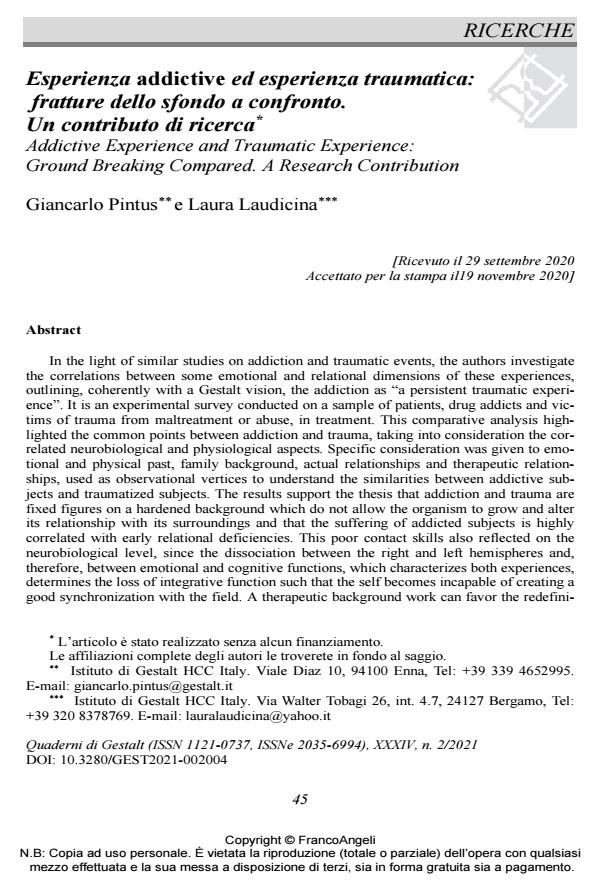Addictive Experience and Traumatic Experience: Ground Breaking Compared. A Research Contribution
Journal title QUADERNI DI GESTALT
Author/s Giancarlo Pintus, Laura Laudicina
Publishing Year 2021 Issue 2021/2
Language Italian Pages 13 P. 45-57 File size 294 KB
DOI 10.3280/GEST2021-002004
DOI is like a bar code for intellectual property: to have more infomation
click here
Below, you can see the article first page
If you want to buy this article in PDF format, you can do it, following the instructions to buy download credits

FrancoAngeli is member of Publishers International Linking Association, Inc (PILA), a not-for-profit association which run the CrossRef service enabling links to and from online scholarly content.
In the light of similar studies on addiction and traumatic events, the authors investigate the correlations between some emotional and relational dimensions of these experiences, outlining, coherently with a Gestalt vision, the addiction as “a persistent traumatic experience”. It is an experimental survey conducted on a sample of patients, drug addicts and victims of trauma from maltreatment or abuse, in treatment. This comparative analysis highlighted the common points between addiction and trauma, taking into consideration the correlated neurobiological and physiological aspects. Specific consideration was given to emotional and physical past, family background, actual relationships and therapeutic relationships, used as observational vertices to understand the similarities between addictive subjects and traumatized subjects. The results support the thesis that addiction and trauma are fixed figures on a hardened background which do not allow the organism to grow and alter its relationship with its surroundings and that the suffering of addicted subjects is highly correlated with early relational deficiencies. This poor contact skills also reflected on the neurobiological level, since the dissociation be-tween the right and left hemispheres and, therefore, between emotional and cognitive functions, which characterizes both experiences, determines the loss of integrative function such that the self becomes incapable of creating a good synchronization with the field. A therapeutic back-ground work can favor the redefinition of the personality-function and the es-function and re-store the spontaneous orientation towards the relationship and neurologically the outcome of this therapeutic action becomes functional reintegration between the two hemispheres. There-fore the support that the Gestalt therapist gives to the addicted and traumatized patient is there-fore aimed at the intentionality of contact never fully satisfied in the organism-environment field.
Keywords: Abuse, addiction, figure-ground, trauma, contact intentionality.
- La ricaduta nell'addiction come espressione del "crollo dello sfondo" Beatrice Petrosino, Giancarlo Pintus, in QUADERNI DI GESTALT 2/2024 pp.11
DOI: 10.3280/qg2024-2oa18194
Giancarlo Pintus, Laura Laudicina, Esperienza addictive ed esperienza traumatica: fratture dello sfondo a confronto. Un contributo di ricerca in "QUADERNI DI GESTALT" 2/2021, pp 45-57, DOI: 10.3280/GEST2021-002004